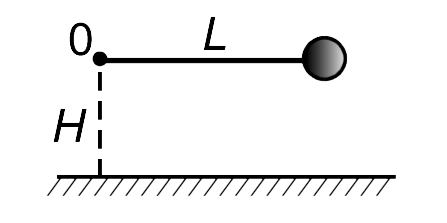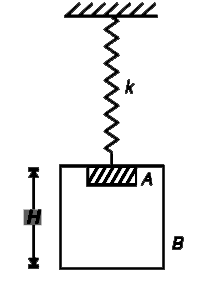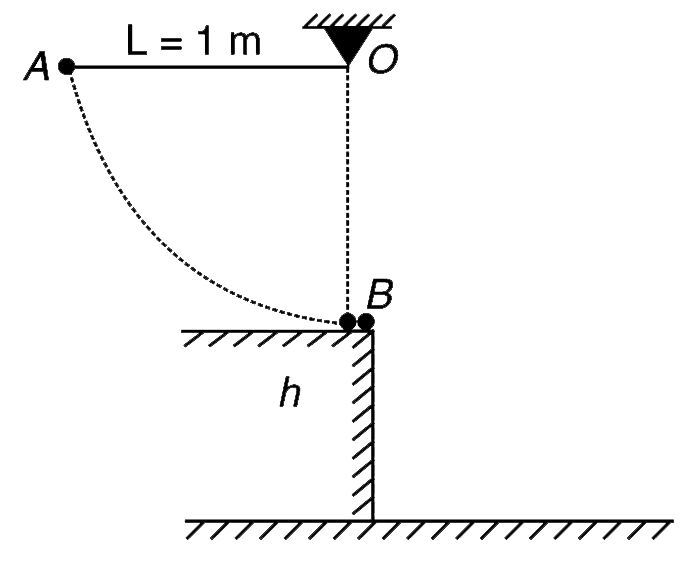A box is put on a scale which is adusted to read zero when box is empty. A stream of pebbles is poured into the box from a height h above it's bottom at a rate μ pebbles/sec. each pebble has a mass m. Consider the collision between pebble and box to be completely inelastic. Find the reading of scale after t seconds of falling of pebbles.
μtmg
μmt√2gh
μm(>−√2gh)
μm(>+√2gh)
The correct Answer is:D
Step by step video, text & image solution for A box is put on a scale which is adusted to read zero when box is empty. A stream of pebbles is poured into the box from a height h above it's bottom at a rate mu pebbles/sec. each pebble has a mass m. Consider the collision between pebble and box to be completely inelastic. Find the reading of scale after t seconds of falling of pebbles. by Physics experts to help you in doubts & scoring excellent marks in Class 11 exams.
Topper's Solved these Questions
- BOOK - ANURAG MISHRACHAPTER - IMPULSE AND MOMENTUMEXERCISE - L-221videos
IMPULSE AND MOMENTUM
- BOOK - ANURAG MISHRACHAPTER - IMPULSE AND MOMENTUMEXERCISE - L-3,(P-1)5videos
IMPULSE AND MOMENTUM
- BOOK - ANURAG MISHRACHAPTER - IMPULSE AND MOMENTUMEXERCISE - Example50videos
IMPULSE AND MOMENTUM
- BOOK - ANURAG MISHRACHAPTER - FORCE ANALYSISEXERCISE - Matching type13videos
FORCE ANALYSIS
- BOOK - ANURAG MISHRACHAPTER - RIGID BODY MOTIONEXERCISE - MATCH THE COLUMN12videos
RIGID BODY MOTION
Similar Questions
A box is put on the platform of a spring balance which is adjusted to zero when the box is empty . A stream of pebbles is then poured into the box from height h above its bottom at a constant rate of n pebbles per second . Find the scale reading t seconds after the pebbles begin to fill the box , assuming that the collisions between the pebbles and the box are completely inelastic .
View SolutionAn empty box is put on the pan of a spring balance and scale is adjusted to zero.A stream of small identical beads,each of mass 4.5gm are then dropped into the box from height 7.6m at constant rate of 100 beads/sec. If the collision between each bead and box is completely inelastic fmd the reading of the scale, 10 seconds after beads begin to hit the box. '
View Solution
Knowledge Check
- Question 1 - Select One
A box is put on a scale which is adjusted to read zero, when the box is empty. A stream of pebbles is then poured into the base from a height h above its bottom at a rate of n pebbles/s. Each pebble has a mass m. If the pebbles collide with the box such that they immediately come to rest after collision, then the scale reading at time t after the pebbles begin to fill the box is [ neglect piling up of pebbles]
AmntBmn[√2gh+gt]CmngtDzero - Question 2 - Select One
Two children are playing a game in which they try to hit a small box using a spring loaded machine gun, which is fixed rigidly to a table at a height h above the top of the box. The spring has spring constant k and the box is at a horizontal distance l from O. The first child compresses the spring a distanc x0 and find that the marble falls short of box by a horizontal distance y. The second child compreses the spring by an extra amount Δx so that marble lands in the box. The value of Δx is
 Al√mghkBl√2mghkC2y√mghkDy√mg2hk
Al√mghkBl√2mghkC2y√mghkDy√mg2hk - Question 3 - Select One
Comprehension:
Read the passage and answer the questions that follow.
The methods of embalming, or treating the dead body, that the ancient Egyptians used is called 'mummification'. Using special processes, the Egyptians removed all moisture from the body, leaving only a dried form that would not easily decay. It was important in their religion to preserve the dead body in as life like a manner as possible. The mummification process took seventy days. Special priests worked as embalmers, treating and wrapping the body. Beyond knowing the correct rituals and prayers to be performed at various stages, the priests also needed a detailed knowledge of human anatomy. The first step in the process was the removal of all internal parts that might decay rapidly. The brain was removed by carefully inserting special hooked instruments up through the nostrils in order to pull out bits of brain tissue. The embalmers then removed the organs of the abdomen and chest through a cut usually made on the left side of the abdomen. They left only the heart in place, believing it to be the center of a person's being and intelligence, The other organs were preserved separately, with the stomach, liver, lungs and intestines placed in special boxes or jars, today called 'canopic jars'. These were buried with the mummy. The embalmers next removed all moisture from the body. This they did by covering the body with 'natron, a type of salt which has great drying properties, and by placing additional natron packets inside the body. When the body had dried out completely, embalmers removed the internal packets and lightly washed the natron off the body. The result was a very dried-out but recognizable human form. To make the mummy seem even more life like, sunken areas of the body were filled out with linen and other materials and false eyes were added. Next the wrapping began. Each mummy needed hundreds of yards of linen. The priests carefully wound the long strips of linen around the body, sometimes even wrapping each finger and toe separately before wrapping the entire hand or foot. In order to protect the dead from mishap in after life, amulets were placed among the wrappings and prayers and magical words written on some of the linen strips. Often the priests placed a mask of the person's face between the layers of head bandages. At last the priests wrapped the final cloth or shroud in place and secured it with linen strips. The mummy was complete. It was then placed in the tomb along with food, furniture, vessels, perfumes, jewels and other things required in the afterlife.
SubQuestion No : 34
Which of the following was NOT buried with the mummies?AAmuletsBCanopic jarsCPerfumesDEmbalmers
A scale is adjusted to zero . Particles fall from a height h = 250 m before colliding with the balance pan of the scale . The collisions are elastic . If each particle has a mass of m = 100 mg and collisions occur at the rate n = 1000 particles per second , what is the scale reading in kg ?
View Solution(i) O is a fixed peg at a height H above a perfectly inelastic smooth horizontal plane. A light inextensible string of length L(>H) has one end attached to O and the other end is attached to a heavy particle. The particle is held at the level of O with string horizontal and just taut and released from rest. Find the height of the particle above the plane when it comes to rest for the first time after the release.

(ii) The bob of a pendulum has mass m and the length of pendulum is l. It is initially at rest with the string vertical and the point of suspension at a height 2l above the floor. A particle P of mass m2 moving horizontally along –ve x-direction with velocity √2gl collides with the bob and comes to rest. The bob swings and when it comes to rest for the first time, another particle Q of mass m moving horizontally along y direction collides with the bob and sticks to it. It is observed that the bob now moves in a horizontal circle.

(a) Find tension in string just before the second collision.
(b) Find the height of the circular path above the floor.
(c) Find the time period of the circular motion.
(d) The string breaks during the circular motion at time t=0. At what time the bob will hit the floor ?View SolutionA box B of mass M hangs from an ideal spring of force constant k. A small particle, also of mass M, is stuck to the ceiling of the box and the system is in equilibrium. The particle gets detached from the ceiling and falls to strike the floor of the box. It takes time t for the particle to hit the floor after it gets detached from the ceiling. The particle, on hitting the floor, sticks to it and the system thereafter oscillates with a time period T. Find the height H of the box if it is given that t=T6√2. Assume that the floor and ceiling of the box always remian horizontal.
 View Solution
View Solution(i) A small steel ball (B) is at rest on the edge of a table of height h. Another identical steel ball (A) is tied to a light string of length L =1.0 m and is released from the position shown so that it swings like a pendulum. At the lowest position of its path it hits the ball B which is at rest. Ball B flies off the table and hits the ground in time t. After collision the ball A keeps moving for a time t before coming to rest for the first time. Find the value of h if t = t. Collision between the balls is head on and coefficient of restitution is e = 0.995.
(ii) A pendulum has a particle of mass m attached to a massless rod of length L. The rod is released from a position where it makes an angle θ0(>π2) with the vertical. The time period of oscillation is observed to be T0. Another similar pendulum has a rod of length 2L. Time period of this pendulum when released from position θ0 is T. Which is larger T or T0 ?
 View Solution
View SolutionThere are three passages in this section. Each passage is followed by five questions. Read each passage carefully and answer the questions that follow. For each question four probable answers bearing letters (A), (B) , (C ) and (D) are given. Only one out of these is correct. You have to choose the correct answer and write the letter in the given box.
Passage-I
A Jeweller, when peeped through his shop into the lane, saw a well dressed women getting of her car. Along with her pet she moved forward and rang the bell. Curiously, the shopkeeper let her in. After an hour or so the curiosity subsided. The women with atmost care looked at the trays containing diamond, at the counter in front of her nodded her head and asked for something else. In the end she asked for the tray-5 to be shown once again. The Jeweller was very happy from within because the said tray contained the most valuable diamonds. When he brought the tray, the woman moved forward and dashed with the jeweller, resulting in all the diamond scttered hither-thither. The woman cut a sorry figure and jeweller looked at her timidly. She helped him picking the diamonds. In the mean while, she took out a piece of biscuit out of her purse and fed her dog. When jeweller could pick the piece of diamond he felt something to stop his heart beat. A 5 carate diamond was seen no where. Excitedly he looked around the entire floor but all in vein. Then he suspeciously looked at the woman and called the police. At the request of the jeweller the police searched the woman but could find nothing. The jeweller realized that the clever woman has cheated on him.
In the above passage tray-5 is important, because -View Solution

